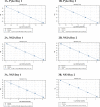Development of an improved RT-qPCR Assay for detection of Japanese encephalitis virus (JEV) RNA including a systematic review and comprehensive comparison with published methods
- PMID: 29570739
- PMCID: PMC5865736
- DOI: 10.1371/journal.pone.0194412
Development of an improved RT-qPCR Assay for detection of Japanese encephalitis virus (JEV) RNA including a systematic review and comprehensive comparison with published methods
Abstract
Background: Japanese encephalitis virus (JEV) is a major cause of encephalitis in Asia, and the commonest cause of mosquito-borne encephalitis worldwide. Detection of JEV RNA remains challenging due to the characteristic brief and low viraemia, with 0-25% of patients positive, and the mainstay of diagnosis remains detection of anti-JEV IgM antibody.
Methods: We performed a systematic review of published RT-PCR protocols, and evaluated them in silico and in vitro alongside new primers and probes designed using a multiple genome alignment of all JEV strains >9,000nt from GenBank, downloaded from the NCBI website (November 2016). The new assays included pan-genotype and genotype specific assays targeting genotypes 1 and 3.
Results: Ten RT-qPCR assays were compared, a pre-existing in-house assay, three published assays and six newly designed assays, using serial RNA dilutions. We selected three assays, one published and two novel assays, with the lowest limit of detection (LOD) for further optimisation and validation. One of the novel assays, detecting NS2A, showed the best results, with LOD approximately 4 copies/ reaction, and no cross-reaction on testing closely related viruses in the JEV serocomplex, West Nile Virus and St. Louis Virus. The optimised assays were validated in consecutive patients with central nervous system infections admitted to hospitals in Laos, testing paired CSF and serum samples.
Conclusions: We succeeded in developing a JEV specific RT-qPCR assay with at least 1 log10 improved sensitivity as compared to existing assays. Further evaluation is required, field-testing the assay in a larger group of patients.
Conflict of interest statement
Figures

Similar articles
-
European Preparedness for Japanese Encephalitis Virus Through Alignment of Animal Health Laboratory Diagnosis.Transbound Emerg Dis. 2025 Jun 10;2025:5516160. doi: 10.1155/tbed/5516160. eCollection 2025. Transbound Emerg Dis. 2025. PMID: 40529624 Free PMC article.
-
Meta-analyses of the proportion of Japanese encephalitis virus infection in vectors and vertebrate hosts.Parasit Vectors. 2017 Sep 7;10(1):418. doi: 10.1186/s13071-017-2354-7. Parasit Vectors. 2017. PMID: 28882172 Free PMC article.
-
Assessment of data on vector and host competence for Japanese encephalitis virus: A systematic review of the literature.Prev Vet Med. 2018 Jun 1;154:71-89. doi: 10.1016/j.prevetmed.2018.03.018. Epub 2018 Mar 22. Prev Vet Med. 2018. PMID: 29685447
-
Antibody tests for identification of current and past infection with SARS-CoV-2.Cochrane Database Syst Rev. 2022 Nov 17;11(11):CD013652. doi: 10.1002/14651858.CD013652.pub2. Cochrane Database Syst Rev. 2022. PMID: 36394900 Free PMC article.
-
Rapid, point-of-care antigen tests for diagnosis of SARS-CoV-2 infection.Cochrane Database Syst Rev. 2022 Jul 22;7(7):CD013705. doi: 10.1002/14651858.CD013705.pub3. Cochrane Database Syst Rev. 2022. PMID: 35866452 Free PMC article.
Cited by
-
Review of Emerging Japanese Encephalitis Virus: New Aspects and Concepts about Entry into the Brain and Inter-Cellular Spreading.Pathogens. 2019 Jul 26;8(3):111. doi: 10.3390/pathogens8030111. Pathogens. 2019. PMID: 31357540 Free PMC article. Review.
-
A need to raise the bar - A systematic review of temporal trends in diagnostics for Japanese encephalitis virus infection, and perspectives for future research.Int J Infect Dis. 2020 Jun;95:444-456. doi: 10.1016/j.ijid.2020.03.039. Epub 2020 Mar 20. Int J Infect Dis. 2020. PMID: 32205287 Free PMC article.
-
Development and comparison of loop-mediated isothermal amplification with quantitative PCR for the specific detection of Saprolegnia spp.PLoS One. 2021 Dec 13;16(12):e0250808. doi: 10.1371/journal.pone.0250808. eCollection 2021. PLoS One. 2021. PMID: 34898622 Free PMC article.
-
Mosquito populations originating from nonendemic areas have the potential to transmit recently emerging Japanese encephalitis virus genotype IV.Emerg Microbes Infect. 2025 Dec;14(1):2438661. doi: 10.1080/22221751.2024.2438661. Epub 2025 Jan 2. Emerg Microbes Infect. 2025. PMID: 39655411 Free PMC article.
-
Hundreds-Dollar-Level Multiplex Integrated RT-qPCR Quantitative System for Field Detection.Biosensors (Basel). 2022 Sep 1;12(9):706. doi: 10.3390/bios12090706. Biosensors (Basel). 2022. PMID: 36140090 Free PMC article.
References
-
- Granerod J, Crowcroft NJ. The epidemiology of acute encephalitis. Neuropsychol Rehabilitation. 2007;17:406–28. - PubMed
-
- Granerod J, Tam CC, Crowcroft NS, Davies NWS, Borchert M, Thomas SL. Challenge of the unknown: A systematic review of acute encephalitis in non-outbreak situations. Neurology. 2010;75(10):924–32. doi: 10.1212/WNL.0b013e3181f11d65 - DOI - PubMed
-
- Boucher A, Herrmann JL, Morand P, Buzele R, Crabol Y, Stahl JP, et al. Epidemiology of infectious encephalitis causes in 2016. Med Mal Infect. 2017. - PubMed
-
- Wang H, Liang G. Epidemiology of Japanese encephalitis: past, present, and future prospects. Therapeutics and Clinical Risk Management. 2015;11:435–48. doi: 10.2147/TCRM.S51168 - DOI - PMC - PubMed
-
- Campbell G, Hills S, Fischer M, Jacobson J, Hoke C, Hombach J, et al. Estimated global incidence of Japanese encephalitis:. Bulletin of the World Health Organization. 2011;89:766–74. doi: 10.2471/BLT.10.085233 - DOI - PMC - PubMed
Publication types
MeSH terms
Grants and funding
LinkOut - more resources
Full Text Sources
Other Literature Sources

